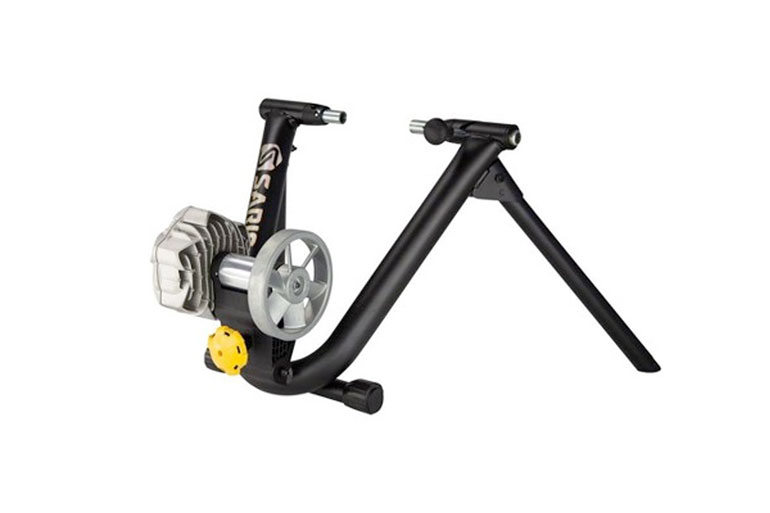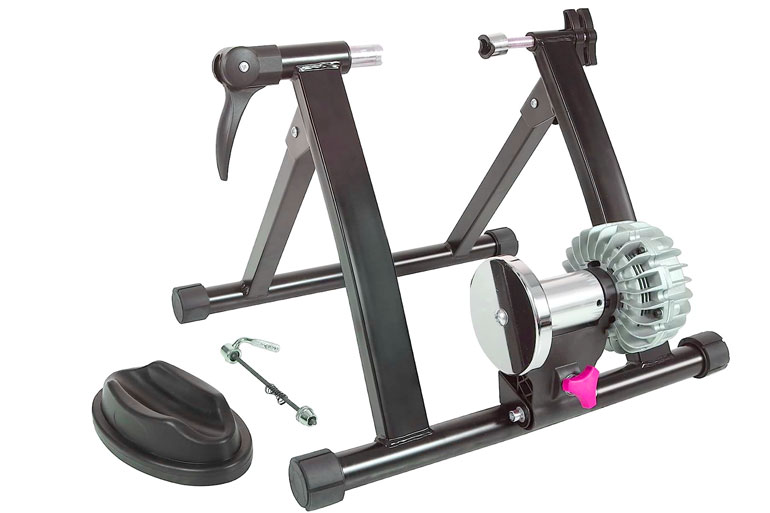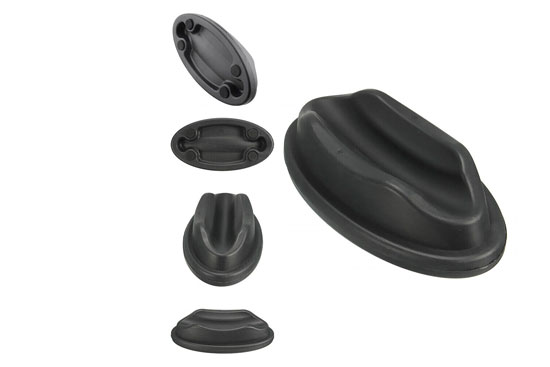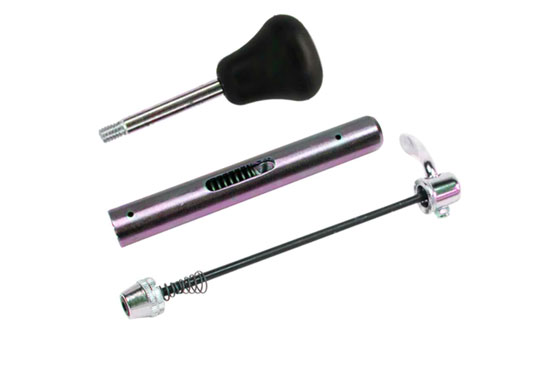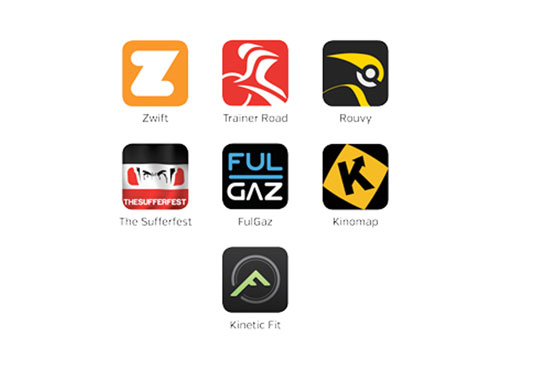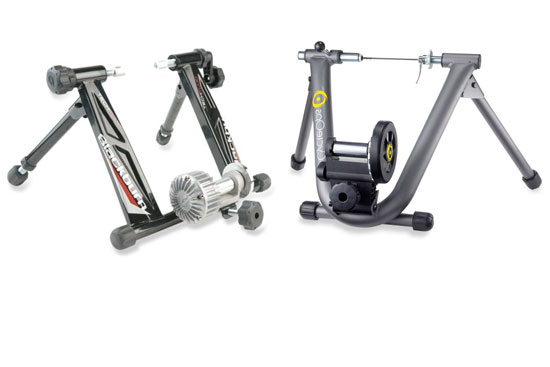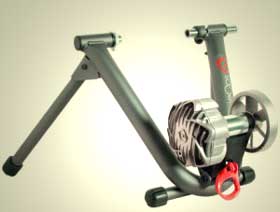Fluid Trainer
When it comes to trainers, there’s a variety to choose from, and if you’re looking for a top-notch option, a fluid bike trainer should be on your radar.
These bad boys offer a bunch of cool features that make them stand out.
First off, they’re super compact, which means you won’t have to sacrifice much space in your home.
But what really sets them apart is the way they make you feel like you’re riding on the open road. The magnetic flywheel is combined with a fluid chamber to produce the resistance. The harder you pedal the greater the resistance produced.
The resistance they provide mimics that real road feel, giving you a more authentic cycling experience.
And let’s not forget about their almost magical silent operation. No more disturbing the peace with noisy workouts.
With a fluid bike trainer, you can pedal away without making a ruckus. It’s the perfect blend of convenience and performance.
Keep in mind that quality and features will vary with different brands so either try one out in person or hop online and watch a video of a real person reviewing fluid bike trainers.
Quick Overview of Pros & Cons of the Fluid Trainer
| PROS Of The Fluid Trainer | CONS Of The Fluid Trainer |
|---|---|
|
|
The Case FOR a Fluid Bike Trainer (Pros)
Fluid trainers offer several advantages that make them a popular choice among cyclists:
Realistic Road Feel:
Fluid trainers are known for providing a more realistic road-like feel compared to other types of trainers. The fluid resistance unit uses a propeller or impeller immersed in fluid to generate resistance as you pedal. This design creates a smooth and progressive resistance that closely mimics the feeling of riding on the road.
Quiet Operation:
Fluid trainers are generally quieter compared to other types of trainers. The fluid resistance system produces minimal noise, allowing you to train without disturbing others or causing distractions. This is especially beneficial if you live in an apartment or have close neighbors.
Progressive Resistance:
Fluid trainers offer progressive resistance, meaning the resistance increases as you pedal harder or shift to higher gears. This allows you to simulate different terrains and adjust the intensity of your workouts accordingly. The resistance feels more natural and closely mirrors the experience of riding outdoors.
Compact and Portable:
Fluid trainers are often compact and lightweight, making them easy to set up, store, and transport. Many models feature foldable designs that allow for convenient storage in smaller spaces when not in use. This portability is advantageous if you have limited space or want to take your trainer on the go for race warm-ups or training sessions while traveling.
Durability:
Fluid trainers are built to withstand high-intensity workouts and prolonged use. The fluid resistance unit typically operates smoothly and reliably, requiring minimal maintenance. The durability of fluid trainers ensures they can handle intense training sessions and provide long-lasting performance.
Wide Range of Resistance:
Fluid trainers typically offer a wide range of resistance levels to accommodate different fitness levels and training goals. Whether you’re a beginner looking for an easy spin or an advanced cyclist seeking a challenging workout, fluid trainers can provide the necessary resistance to meet your needs.
The Case AGAINST a Fluid Bike Trainer (Cons)
While fluid trainers have numerous advantages, there are also a few potential drawbacks to consider:
Higher Price:
Fluid trainers tend to be more expensive compared to other types of trainers on the market. The advanced technology and smooth resistance system contribute to their higher price point. If you’re on a tight budget, a fluid trainer may not be the most cost-effective option.
Fluid Leakage:
Although rare, fluid leakage can occur in some fluid trainers. Over time, the seals or connections within the resistance unit may wear out, leading to leaks. While this is not a common issue, it can result in a messy and potentially costly repair or replacement.
Limited Adjustability:
Fluid trainers generally offer limited adjustability in terms of resistance. Unlike smart trainers or magnetic trainers, which often have programmable resistance settings or adjustable levels, fluid trainers typically provide a fixed resistance curve. This can make it more challenging to fine-tune your workout intensity or replicate specific training scenarios.
Heat Build-Up:
Fluid trainers generate heat during use due to the friction between the fluid and the internal components. Prolonged and intense sessions can lead to an increase in temperature, potentially affecting the performance and longevity of the trainer. It’s important to ensure proper ventilation and avoid excessive heat buildup.
Bulkier Design:
While fluid trainers can be compact and portable compared to other types of trainers, they still tend to have a bulkier design compared to direct-drive or wheel-on smart trainers. This can make them slightly more challenging to store or transport, especially if you have limited space.
It’s worth noting that these drawbacks are relatively minor and may not be significant concerns for all cyclists. Consider your specific needs, budget, and training goals when deciding whether a fluid trainer is the right choice for you.
Buying Guide for Fluid Trainers
What You Should Consider Before Buying
Are you considering purchasing a fluid trainer for your indoor cycling needs?
Look no further!
Our buying considerations guide for fluid trainers is here to help you make an informed decision.
We’ll walk you through the key factors to consider, such as resistance levels, compatibility, stability, noise, and more.
With our expert tips and insights, you’ll be well-equipped to choose the perfect fluid trainer that suits your training goals and preferences.
Get ready to elevate your indoor cycling experience and achieve your fitness goals. Let’s get started!
Is Your Fluid Trainer Compatible With Your Bike Wheel?
When considering a fluid trainer for your bike, it’s essential to ensure compatibility between the trainer and your bike’s wheel. Here are some key points to keep in mind:
Wheel Size:
Fluid trainers are typically designed to accommodate common wheel sizes, such as 26-inch, 27.5-inch (650b), and 29-inch for mountain bikes, and 700c for road bikes. Check the specifications of the trainer to ensure it supports your bike’s wheel size
Rear Dropout Spacing:
The rear dropout spacing refers to the distance between the rear wheel dropouts on your bike’s frame. Most fluid trainers can accommodate standard rear dropout spacings, which are typically 130mm for road bikes and 135mm for mountain bikes. Ensure that the trainer you choose is compatible with your bike’s dropout spacing.
Thru-Axle or Skewer:
Pay attention to the type of axle system your bike uses. Some fluid trainers are designed to work with quick-release skewers, while others support thru-axle systems. Make sure the trainer you select matches the axle system of your bike.
Additional Adapters:
In some cases, you may need additional adapters or conversion kits to ensure proper compatibility between the trainer and your bike’s wheel. These adapters can accommodate different axle sizes or types. Check with the trainer manufacturer or consult a bike shop to determine if any additional adapters are required.
It’s always a good idea to consult the manufacturer’s guidelines or contact their customer support to confirm compatibility between your bike and the fluid trainer you’re considering. By ensuring the right fit, you’ll be able to enjoy a smooth and effective indoor cycling experience.
You Will Need A Riser Block
When setting up your bike on a trainer, it’s important to ensure that it is positioned correctly for a comfortable and effective workout.
One accessory that is often necessary is a riser block.
This simple device is placed under the front wheel to elevate it and align it with the rear wheel. Without a riser block, your bike would be in a downward-leaning position, which can feel awkward and affect your riding form.
In addition to a riser block, you may also need a quick-release skewer, depending on the type of trainer and your bike’s frame.
Some trainers require you to replace your bike’s original skewer with a provided quick-release skewer that is designed to fit into the trainer’s clamping system. This ensures a secure and stable connection between your bike and the trainer.
The good news is that many fluid trainers come with additional accessories included in the purchase. This can include a riser block, quick-release skewer, or even a convenient carry bag to transport and store your trainer.
Be sure to check the product details to see what accessories are included with your trainer to ensure you have everything you need for a smooth and enjoyable indoor cycling experience.
Does Size Matter?
One great thing about fluid trainers is their size – they’re perfect for those who value space-saving solutions.
Fluid trainers are generally designed to be space-efficient and easy to store when not in use.
Here’s why their size is a great feature:
Compact Design
Fluid trainers are typically designed to have a smaller footprint compared to other types of trainers. These trainers are typically compact, measuring no more than 76 centimeters or 30 inches in length and width. They are often sleek and streamlined, making them ideal for home use where space may be limited.
Portability
Many fluid trainers feature a foldable frame, allowing for easy storage and transportation. The foldable design enables you to conveniently pack and take the trainer with you, whether you want to use it in different rooms or bring it along on your cycling trips.
Versatile Storage
Options: Due to their compact size, fluid trainers can be stored in various locations, such as closets, under beds, or even in the trunk of your car. Their smaller dimensions make it easier to find a suitable storage spot that doesn’t take up much space in your living area.
Convenience for Small Spaces
If you live in an apartment or have a limited workout area, a fluid trainer can be an excellent choice. Its smaller size allows you to set up a training station without occupying too much room, making it more practical for indoor cycling workouts. In comparison, models like the wind resistance trainers, and some magnetic trainers can be a bit bulkier and take up more room.
Overall, the compact size of fluid trainers offers convenience and flexibility, making them a popular choice for cyclists who want to train at home without sacrificing a significant amount of space.
Is Resistance Important?
When it comes to the resistance and feel of your trainer, fluid trainers have some serious advantages over their magnetic or wind counterparts.
They’re all about that authentic road-like experience!
Just like riding your trusty road bike, fluid trainers provide progressive resistance, which means the challenge increases as you pedal harder and faster.
It’s like having the real road right in your living room!
But here’s the deal: not all fluid trainers are created equal. Some offer a smoother and more realistic feel than others. If possible, it’s always a good idea to try out a unit before making a purchase.
Here’s why resistance is important:
Intensity and Challenge:
Resistance determines the level of difficulty you experience while pedaling on a bike trainer. It allows you to replicate outdoor riding conditions and adjust the intensity of your workouts. By increasing the resistance, you can make your training sessions more challenging and target specific muscle groups for strength and endurance.
Progressive Training:
Fluid trainers, in particular, offer progressive resistance. This means that as you pedal faster or apply more force, the resistance increases proportionally. This feature allows for a more realistic cycling experience and helps you build strength and power over time. It mimics the feeling of riding on different terrains, where pedaling harder results in increased resistance.
Variety in Workouts:
Having adjustable resistance levels on a fluid trainer enables you to vary your workouts. You can simulate flat terrain, uphill climbs, or interval training by adjusting the resistance accordingly. This versatility helps you customize your training sessions to meet specific goals, whether it’s improving endurance, building strength, or engaging in high-intensity interval training.
Tracking Progress:
Resistance settings on fluid trainers can often be quantified, allowing you to track your progress over time. By measuring the resistance level or power output during your workouts, you can monitor improvements in your fitness and set new goals to challenge yourself.
Realistic Ride Feel:
Fluid trainers are known for providing a more road-like feel compared to other types of trainers. The progressive resistance closely simulates the sensation of riding outdoors, giving you a smoother and more realistic experience. This enhances your training sessions and makes them more enjoyable.
In summary, resistance plays a significant role in bike trainers, including fluid trainers, as it determines the intensity, challenge, and realism of your indoor cycling workouts. It allows you to tailor your training sessions, track progress, and achieve your fitness goals effectively.
You might come across a few trainers that aren’t very smooth to start with, but fear not, my friend! As the as the oil/fluid heats up that issue usually evens out and your resistance will increase.
Strength & Stability of the Frame
Let’s talk about frame strength and stability.
When it comes to a fluid bike trainer, you want a frame that’s as tough as nails and stable as a rock.
Why?
Well, because you’re going to be cranking up that intensity and giving it all you’ve got. So, the frame needs to handle the heat, literally and figuratively.
Look for a wide base that has some serious friction with the floor. You don’t want any wobbling or slipping when you’re in the zone.
The weight of the frame is another thing you need to consider. It’s a delicate balance.
You want a trainer that’s sturdy and stable, but not so heavy that it becomes a pain in the neck to transport.
As for the frame material, steel tubing is the go-to choice for most fluid trainers. It’s strong enough to handle the demands of most riders and workout routines.
Securing Your Bike to the Fluid Trainer
How do you secure your bike to the stationary stand?
Well, with a fluid trainer there are two main types of mechanisms.
The first one is a bolt-action lever. It’s quick, easy, and locks your bike in place in a jiffy.
The other type uses threaded knobs (one or two of them). It may take a bit more time to attach this mechanism but it does lock it into place more securely.
You need to choose the locking system that suits your style, safety concerns and patience.
Which Type of Flywheel?
When it comes to fluid bike trainers, there are two types to consider based on the flywheel design.
Let’s break it down for you.
The more common type features an external flywheel that’s connected to the impeller and resistance unit through an axle. This setup ensures a smooth and consistent motion during your workouts.
Now, the second type is a bit different.
In this case, the impeller itself acts as the flywheel.
While both systems work effectively, we do know that a heavier flywheel tends to provide an even smoother ride. That’s why you’ll find the first type, with its larger flywheel, more commonly available.
So, whether you’re opting for the external flywheel or the impeller-flywheel combo, rest assured that both options will get you pedaling with power and enjoying a satisfying workout experience.
What is a Roller?
Alright, let’s talk about the roller, the part that gets up close and personal with your bike’s wheel.
Most rollers are made of shiny aluminum and sport smooth surfaces. A larger diameter roller is better.
Why, you ask?
Well, it’s all about reducing wear and tear on your precious tyres. We all know that tyres go through enough adventures on the road, so it’s nice to have a roller that treats them with care.
Noise Levels
When it comes to enjoying a peaceful workout at home, silence is golden.
Thankfully, most fluid resistance trainers are designed with noise reduction in mind. The fluid resistance mechanism generates minimal noise.
These trainers aim to keep the unwanted sounds to a minimum, allowing you to focus on your ride without disturbing the tranquility of your surroundings.
However, it’s important to note that noise levels can vary between different models due to factors such as construction, quality, and materials used.
Additionally, factors like the material of the roller, the type of tyre you have and the design of the resistance unit, can all play a role in the overall noise produced.
While you can’t completely eliminate the natural sounds that come from the moving parts of your bike, investing in a high-quality fluid trainer and maintaining your bike properly can help create a more serene and enjoyable indoor cycling experience.
So, pedal away in peace and savor the quiet rhythm of your home workouts – or enjoy watching your TV without needing to have the volume blaring!
Maintaining A Fluid Bike Trainer
Maintaining a fluid bike trainer is relatively simple.
Regularly check the trainer for any signs of wear or damage and ensure that all connections are secure.
Keep the roller and resistance unit clean and free from dirt, debris, and excessive lubrication.
If your trainer has an external flywheel, lubricate it as per the manufacturer’s recommendations.
It’s also a good idea to periodically check the fluid levels and replace it if necessary.
Following the manufacturer’s maintenance instructions will help prolong the lifespan and performance of your fluid bike trainer.
Digital Enhancements – Apps & Accessories
Sensors and apps play a significant role in enhancing your indoor cycling experience by providing valuable data and interactive features. Here’s what you need to know about them:
Speed and Cadence Sensors
These sensors are typically attached to your bike and provide real-time data on your speed and cadence (pedaling rate). They help you monitor your performance and maintain consistent training intensity.
Power Meter
A power meter measures the actual power output generated while pedaling. It provides precise and objective data, allowing you to track your progress, set training goals, and participate in virtual competitions. Power meters are usually integrated into the trainer or can be added to your bike separately.
Heart Rate Monitor
Monitoring your heart rate during workouts is an effective way to gauge your effort level and ensure you’re training within your desired intensity zones. Heart rate monitors can be chest straps or optical sensors worn on your wrist.
Smart Trainer Compatibility
Many modern trainers are equipped with built-in sensors that transmit data wirelessly to compatible apps and devices. These trainers can measure speed, power, and cadence without the need for additional sensors. They also provide interactive features such as automatic resistance adjustments based on virtual terrain or training programs.
Cycling Apps
There are numerous cycling apps available that offer a range of features to enhance your training sessions. These apps can connect to your trainer and sensors, providing real-time data, virtual training environments, structured workouts, and even social interaction with other cyclists. Some popular apps include Zwift, TrainerRoad, and Rouvy.
When choosing a sensor or app, ensure compatibility with your trainer and preferred device (smartphone, tablet, or computer).
Also, consider the features and functionalities that align with your training goals and preferences.
It’s worth exploring different options to find the combination that suits your needs and helps you make the most out of your indoor cycling sessions.
The Difference Between a Fluid Bike Trainer & a Magnetic Bike Trainer
A fluid bike trainer utilizes a casing filled with fluid, such as oil or liquid silicone, to create resistance. As you pedal, the roller rotates and the impeller inside the fluid generates resistance. This type of trainer provides a progressive resistance that closely simulates outdoor riding.
On the other hand, a magnetic bike trainer uses magnets to create resistance. The magnets create a magnetic field that interacts with a metal flywheel, generating resistance as you pedal.
Magnetic trainers offer adjustable resistance levels but may not provide the same road-like feel as fluid trainers.
The choice between a fluid trainer and a magnetic trainer ultimately depends on your preferences and training goals.
Fluid trainers are favored for their road-like feel and progressive resistance, closely mimicking outdoor riding conditions. They provide a smoother and more realistic experience, making them popular among serious cyclists.
On the other hand, magnetic trainers offer adjustable resistance levels, making them suitable for various training intensities. They are generally more affordable and provide a consistent resistance.
Consider your specific needs, budget, and desired riding experience to determine which type of trainer is the best fit for you.
How Does a Fluid Bike Trainer Effect My Wheel?
Trainers can have an impact on the bike’s rear wheel over time.
The main effect is wear on the tire due to the friction between the tire and the roller or resistance unit of the trainer.
The constant contact and pressure can cause the tire to wear out faster compared to regular outdoor riding.
To mitigate this, some cyclists use old or spare wheels specifically dedicated for trainer use. Another option is to use a trainer-specific tire, which is designed to withstand the friction and heat generated during indoor training sessions.
These tires are made of a harder compound and are more resistant to wear. By using a trainer-specific tire, you can prolong the life of your regular outdoor tire and have a smoother experience on the trainer.

